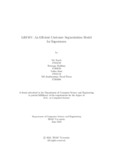LRFMV: an efficient customer segmentation model for superstores
Abstract
In superstore business, the recency, frequency, and monetary (RFM) based on cus tomers’ purchase results is preferred to categorize valuable customers in order to
increase profit margins. This paper develops an enhanced RFM (recency, fre quency, monetary) and LRFM (length, recency, frequency, monetary) model, namely
LRFMV (length, recency, frequency, monetary, and volume), and then clusters the
data using the standard K-means, K-medoids and Mini Batch K-means algorithms.
The results obtained from the three algorithms are compared and the K-means al gorithm is chosen for the superstore dataset of the proposed LRFMV model. All
clusters created using these three algorithms are evaluated in the LRFMV model and
a close relationship between profit and volume is observed. A clear profit-quantity
relationship of items has yet not been seen in any prior study on the RFM and LRFM
models. Grouping customers aiming at the profit maximization existed previously
but there were no clear and direct depiction of profit and quantity of sold items.
To establish a relationship between volume and profit, this study applied unsuper vised machine learning to investigate the patterns, trends, and correlations between
these two variables. The traits of all the clusters are analyzed by the Customer Classification Matrix. The values of LRFMV variables that are larger or less than
the overall average for each cluster are identified and utilised as their traits. The
RFM model, the LRFM model and the suggested LRFMV model are compared, and
the outcome indicates that the LRFMV model may create more segments with the
same number of customers while maintaining a greater profit per head.

